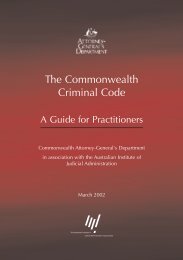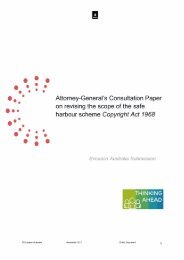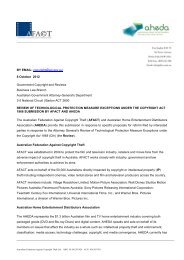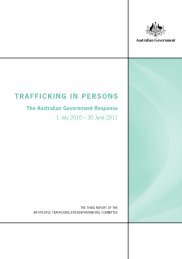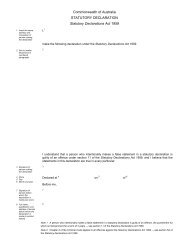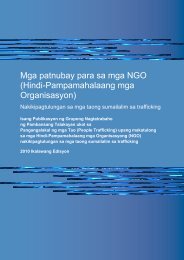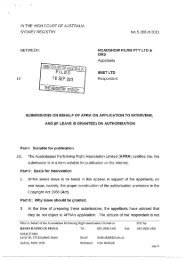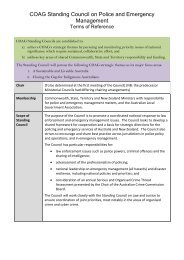Normann Witzleb [PDF 657KB] - Attorney-General's Department
Normann Witzleb [PDF 657KB] - Attorney-General's Department
Normann Witzleb [PDF 657KB] - Attorney-General's Department
Create successful ePaper yourself
Turn your PDF publications into a flip-book with our unique Google optimized e-Paper software.
surveillance in public places, the VLRC did not expressly deal with other forms of privacy<br />
invasions. Its report nonetheless expressed reservations against broadly expressed<br />
rights to privacy. 75<br />
Comment<br />
48 Despite these variations, closer inspection reveals that the differences between the<br />
various proposals relate to legislative style and drafting, rather than to the substance<br />
and scope of the proposed privacy action. Referring to obiter comments in Australian<br />
Broadcasting Corporation v Lenah Game Meats Pty Ltd, 76 all three commissions<br />
recommend that the statutory cause of action be limited to the misuse of personal<br />
information and unauthorised intrusion into the plaintiff’s private life. This means in<br />
particular that those invasions that, in US law, are classified as ‘publicity which places a<br />
person into a false light in the public eye’ and ‘appropriation, for the defendant’s<br />
advantage, of the plaintiff’s name or likeness’ would not be covered by the statutory<br />
cause of action. 77<br />
49 However, while there is thus consensus on the recommended scope of the privacy<br />
action, there are differences in relation to the stringency with which such other forms of<br />
privacy invasion are excluded. The VLRC proposes the clearest form of exclusion<br />
because it recommends that only serious invasions of privacy by misuse of personal<br />
information and by intrusion upon seclusion should become actionable. Other forms of<br />
privacy invasion would be actionable only where they happen to fulfil the criteria of the<br />
two specified causes of action, or are picked up by existing statutory or general law. Any<br />
privacy protection in those cases would thus be incidental. The ALRC proposal is less<br />
straightforward. Its list of typical scenarios of privacy infringements is intended to be<br />
‘useful in indicating to the courts the scope of the action’. 78 The existence of this list will<br />
presumably make it more difficult to persuade a court to accept a privacy action where<br />
the conduct does not fit any of the statutory scenarios, but considering that the list is<br />
non-exhaustive its normative effect is likely to be limited. Neither the Recommendations<br />
nor the Report suggest in what circumstances a court should find a privacy infringement<br />
in a scenario omitted from the list. The Report merely suggests that it is ‘questionable’<br />
whether placing a person into a false light or using a person’s name, identity, likeness or<br />
voice without authority for commercial gain is properly regarded as an invasion of<br />
privacy 79 and that it is ‘undesirable’ 80 to include the latter scenario in the list. Such an<br />
approach causes uncertainty and is likely to require litigation to achieve further<br />
clarification.<br />
50 In a similar vein, the report of the NSWLRC refers to a ‘widespread understanding [in<br />
Australia] that the role of privacy in private law is to protect information privacy and<br />
75 VLRC Report, at [7.123].<br />
76 Australian Broadcasting Corporation v Lenah Game Meats Pty Ltd (2001) 208 CLR 199; [2001] HCA 63.<br />
77 W Prosser, ‘Privacy’ (1960) 48 California Law Review 383, 388-389; American Law Institute,<br />
Restatement (Second) of Torts, § 652B (1977).<br />
78 ALRC Report, at [74.119].<br />
79 Ibid, at [74.120].<br />
80 Ibid, at [74.123].<br />
17


![Normann Witzleb [PDF 657KB] - Attorney-General's Department](https://img.yumpu.com/26247895/17/500x640/normann-witzleb-pdf-657kb-attorney-generals-department.jpg)

